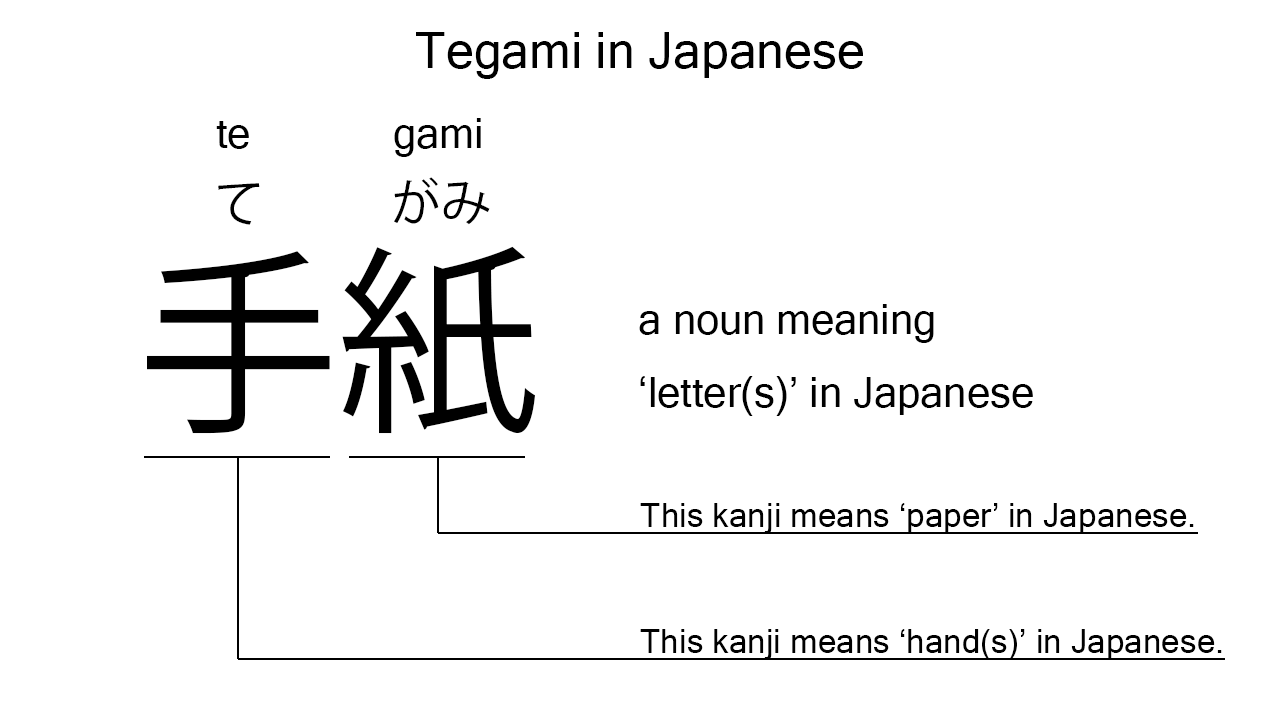What does “tegami” mean in Japanese?
Native speakers say “tegami” to mean ‘letter’ in Japanese. Perhaps, some Japanese learners know this word as it is sometimes used in Japanese movies, songs, novels, manga, anime, and the like. In this blog post, however, I will explain this word in detail based on its kanji expression. And also, I will explain how to use it through example sentences. My explanations would help Japanese learners understand “tegami” more clearly. Then, let’s get started!
Contents
Definition and meanings of “tegami”
Let me start with the definition and meanings of “tegami”.
- tegami – 手紙 (てがみ) : a noun meaning ‘letter’, ‘note’, or such in Japanese. This can also work as plural. Learn more about Japanese plural.
Native speakers use this noun to refer to a hand-written message or messages in Japanese.
The definition and meanings are simple and clear. To understand this noun more clearly, however, let me explain its kanji characters in detail, one by one.
What does “tegami” literally mean in Japanese?
The kanji expression of “tegami” consists of the following two kanji characters:
- 手 : a kanji character used to mean ‘hand’ in Japanese.
- 紙 : a kanji character used to mean ‘paper’ in Japanese.
These two kanji characters tell us that “tegami” literally means ‘hand paper’ in Japanese. This literal interpretation is not completely in line with the actual meanings, but still understandable, I think. Letters often refer to hand-written messages on paper.

When we meet new kanji expressions, we should check their kanji characters in detail to understand their meanings clearly and deeply. In many cases, kanji characters tell us a lot about the meanings of the expressions they form. Actually, here, we could get the better understanding of “tegami” through the detailed kanji check above.
So far, I’ve explained the definition and meanings of “tegami” together with its kanji characters. Then, let me explain how to use it through the example sentences below.
Example #1: how to say “letter” in Japanese
boku wa kanojo ni tegami wo okut ta – 僕は彼女に手紙を送った (ぼくはかのじょにてがみをおくった)
I sent a letter to her.
Below are the new words used in the example sentence.
- boku – 僕 (ぼく) : a pronoun meaning ‘I’ in Japanese. This is used mainly by boys and young males.
- wa – は : a binding particle working as a case marker or topic marker. In the example, this works after “boku” to make the subject in the sentence.
- kanojo – 彼女 (かのじょ) : a pronoun meaning ‘she’ in Japanese.
- ni – に : a case particle used to say to whom an action is directed. In the example, this is used after “kanojo” to say to whom the action, “okut ta”, is directed.
- wo – を : a case particle used to make the object word in a sentence. In the example, this is used after “tegami” to make the object in the sentence.
- okut – 送っ (おくっ) : one conjugation of the verb, “okuru“, which means ‘to send’ in Japanese. In the example, it has been conjugated for the better connection with its following word.
- ta – た : an auxiliary verb used after a verb, adjective, or auxiliary verb to make its past tense form. Probably, this is well known as a part of Japanese ta form. In the example, this is used after “okut” to make its past tense form, “okut ta”.
This is a typical usage of “tegami”. In this example, it works as a part of the commonly-used phrase, “tagami wo okut ta”, which means ‘to have sent a letter’ in Japanese. This phrase should be learnt together with its present tense form, “tegami wo okuru”.
Example #2: another usage of “tegami”
shikashi kanojo wa tegami wo yoma nakat ta – しかし彼女は手紙を読まなかった (しかしかのじょはてがみをよまなかった)
But, she didn’t read the letter.
Below are the new words used in the example sentence.
- shikashi – しかし : a conjunction meaning ‘but’ or such in Japanese.
- yoma – 読ま (よま) : one conjugation of the verb, “yomu“, which means ‘to read’ in Japanese. In the example, it has been conjugated for the better connection with its following word.
- nakat – なかっ : one conjugation of the auxiliary verb, “nai“, which is used after a verb, adjective, or auxiliary verb to deny its meaning. In the example, it has been conjugated for the better connection with its following word.
This is another typical usage of “tegami”. In this example, it works as a part of the phrase, “tegami wo yoma nakat ta”, which literally means ‘not to have read a letter’ in Japanese. When we want to mean a ‘letter’ or ‘letters’ in Japanese, anyway, this noun is always a very good option.
Summary
In this blog post, I’ve explained the definition and meanings of “tegami” in detail based on its kanji expression. And also, I’ve explained how to use it through the example sentences. Let me summarize them as follows.
- tegami – 手紙 (てがみ) : a noun meaning ‘letter’, ‘note’, or such in Japanese. This can also work as plural. Native speakers use this noun to refer to a hand-written message or messages in Japanese. These two kanji characters literally mean ‘hand paper’ in Japanese. This literal interpretation is not completely in line with the actual meanings, but still understandable, I think. Letters often refer to hand-written messages on paper.
Hope my explanations are understandable and helpful for Japanese learners.